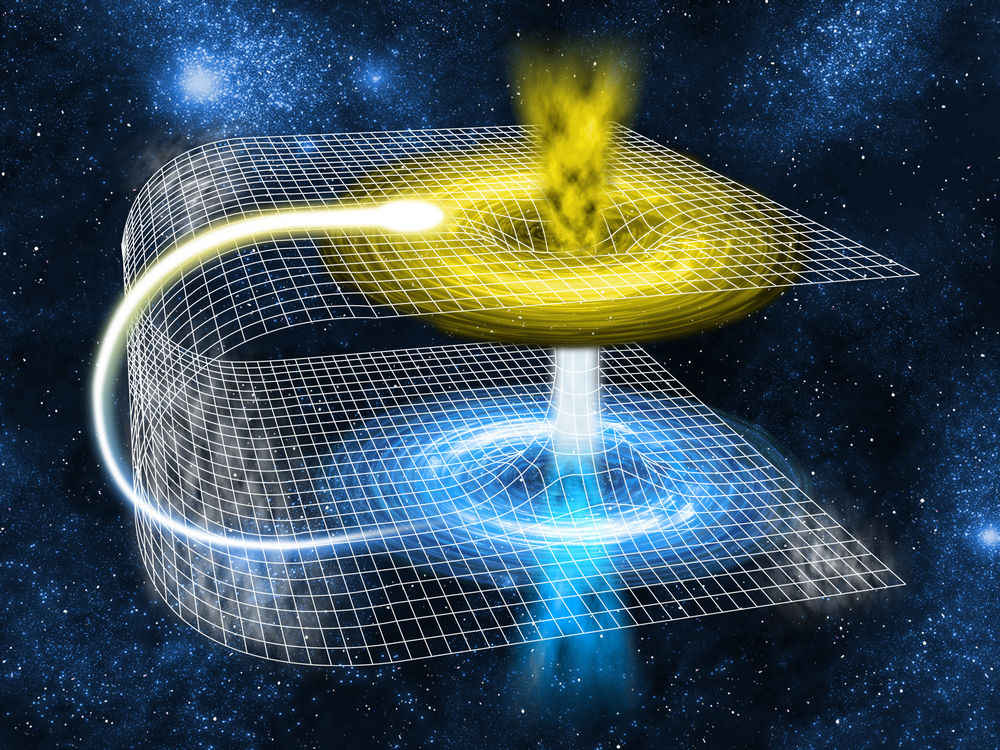Wormholes Could Cast Weird Shadows That Could Be Seen by Telescopes

Wormholes, or hypothetical tunnels through space-time that allow faster-than-light travel, could potentially leave dark, telltale imprints in the sky that might be seen with telescopes, a new study suggests.
These slightly bent, oblong wormhole "shadows" could be distinguished from the more circular patches left by black holes and, if detected, could show that the cosmic shortcuts first proposed by Albert Einstein more than a century ago are, in fact, real, one researcher says.
Wormholes are cosmic shortcuts, tunnels burrowing through hyperspace. Hop in one end, and you could emerge on the other side of the universe — a convenient method of hyperfast travel that's become a trope of science fiction. [8 Ways You Can See Einstein's Theory of Relativity in Real Life]
These sci-fi staples arise from the equations of Einstein's theory of general relativity. Like the space-time around black holes, wormholes are regions where the fabric of space-time is so warped, light no longer travels in a straight line. Photons — or light particles from nearby gas, dust or background stars — careen around the wormhole, generating a ring of light. But photons too close would fall through the wormhole and leave behind a dark, round void called a shadow.
Such a shadow would be similar to those cast by black holes — including the supermassive one at the center of the Milky Way galaxy — which astronomers are now trying to observe directly. Its shadow would appear tiny, so astronomers are linking radio dishes across the globe to form an Earth-sized telescope, called the Event Horizon Telescope. They're now analyzing the first batch of data, which they collected last year.
In the new analysis, published in the preprint journal arXiv on March 30, Rajibul Shaikh, a physicist at the Tata Institute of Fundamental Research in Mumbai, India, found that a certain type of rotating wormhole would cast a larger and more distorted shadow than the one cast by a black hole. As a wormhole spun faster, its shadow would appear a little smooshed, while a black hole's shadow would remain more disk-like.
"Through the observation of their shadows, it might be possible to distinguish between black holes and wormholes," Shaikh told Live Science.
Sign up for the Live Science daily newsletter now
Get the world’s most fascinating discoveries delivered straight to your inbox.
Researchers have calculated a rotating wormhole's shadow before, but they overlooked the effect of the wormhole's "throat," which connects its two ends, Shaikh said. Using the new analysis, astronomers could, in principle, identify a wormhole shadow when they see one. And if they do, it would not only be evidence of something out of science fiction but also indirect evidence for some kind of exotic matter or a modified theory of gravity, he said.
According to general relativity, a wormhole needs exotic (and still theoretical) matter that behaves like antigravity to keep it open, or else it would collapse immediately. Otherwise, a stable wormhole might require us to rethink our understanding of gravity, Shaikh said.
But the new analysis, which has been submitted for peer review in the journal Physical Review D, refers only to a specific class of wormholes. "It has to be studied whether or to what extent the results carry over to broader classes of wormholes," Shaikh said.
This type of wormhole also has a simpler, unrealistic symmetry, said John Friedman, a physicist at the University of Wisconsin-Milwaukee who was not involved in the study. Shaikh's new analysis probably wouldn't apply to a more realistic wormhole because exotic matter is so mysterious.
"It's highly unlikely that macroscopic wormholes exist," Friedman told Live Science. "If they do, the unknown nature of the matter supporting the wormhole makes it impossible to predict the shadow."
Calculating the shadow requires knowing the geometry of the space-time fabric around it. This geometry depends on the properties of exotic matter. But because no one knows what this matter might be, the exact geometry — and thus the shadow — would remain a mystery, Friedman said.
Originally published on Live Science.









